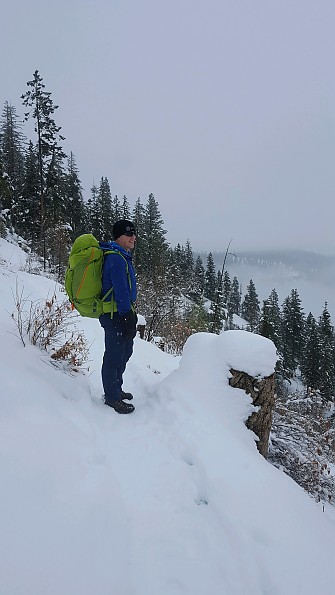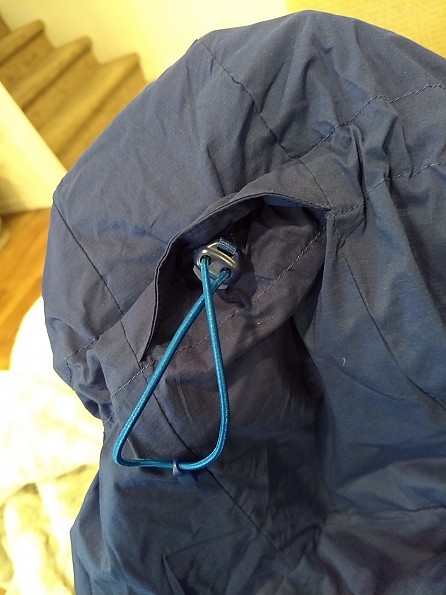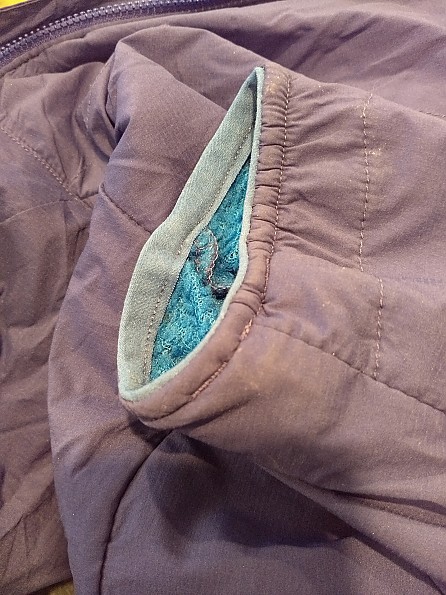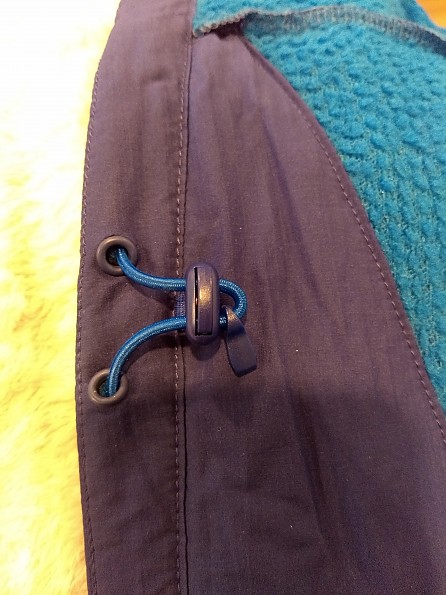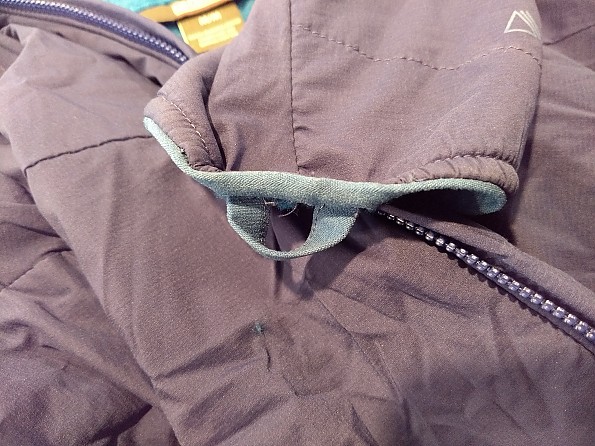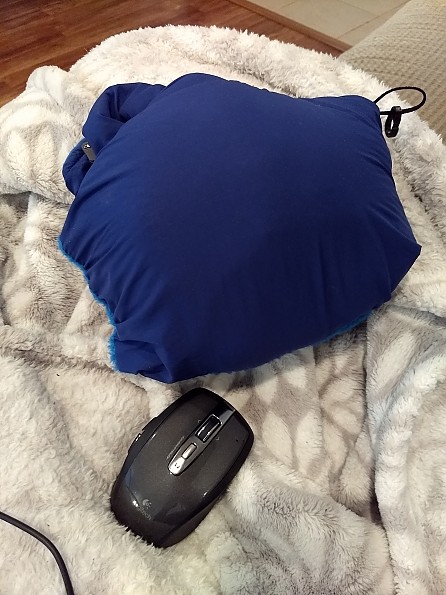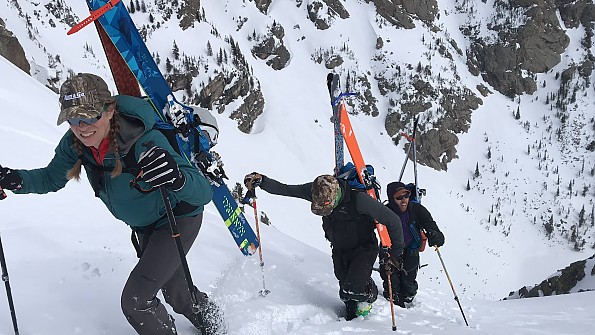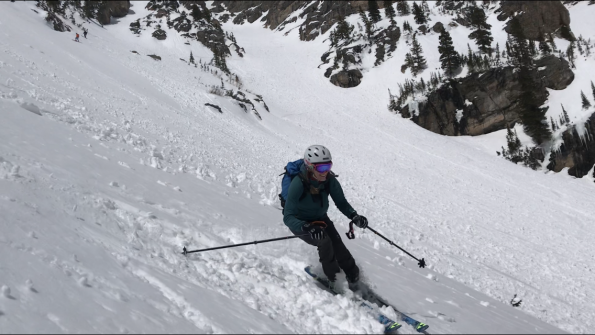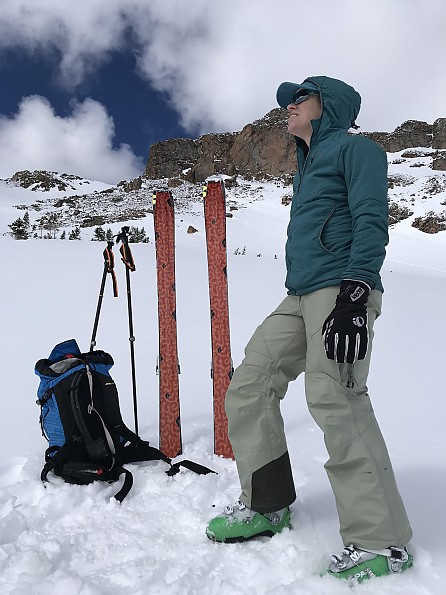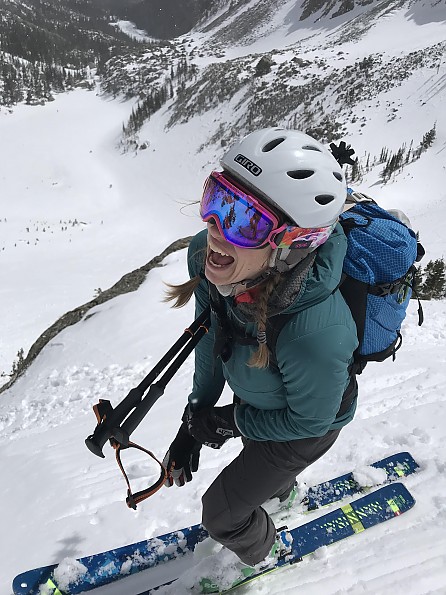Outdoor Research Ascendant Hoody
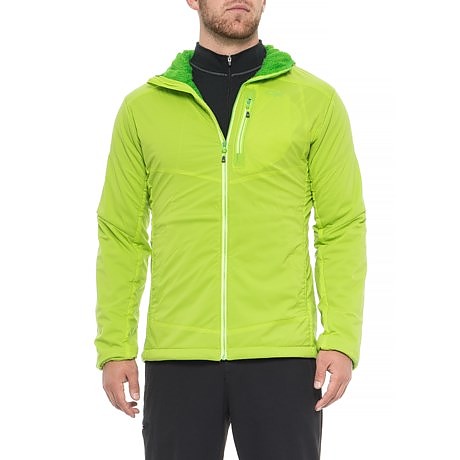
OR questioned everything, took a couple risks, and ended up making my new favorite mid-weight jacket.
Pros
- Without a liner this jacket shaves weight and adds breathability
- Close fitting and stretchy makes layering easy
- Packs into its own pocket
- Lighter than many down jackets
Cons
- Odd cuff loops are a mystery
- Pocket zippers might be nice, but would add weight
"It’s cute, but it looks like you skinned Cookie Monster and made a coat out of him,” said the Mrs. upon her first view of me in the Ascendant jacket.
OR may have made the jacket a little odd by removing the traditional smooth lining to expose the insulation but the oddness makes sense when you consider the benefits.
Don’t want to read the entire review? I fell in love with this jacket and its thoughtful simplicity. It fits my needs for a light mid-layer perfectly. If it fits, you can afford it, and you need one, buy it.
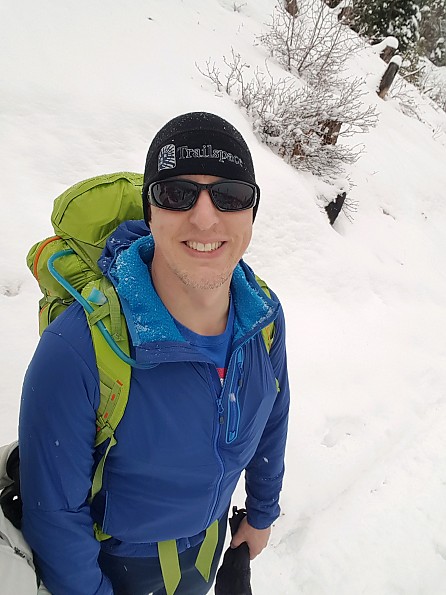 This pic is while hiking hard with temps in the upper twenties with little wind.
This pic is while hiking hard with temps in the upper twenties with little wind.
What this jacket is designed for: In cooler climates, over your base-layer you’ll probably be wearing a light, hooded jacket like this one while you are on the move. Mark Twight calls it your “action suit.” You’ll unzip this jacket when you are warming up, you’ll put up the hood and toss a shell or a puffy over it when you stop, but you’ll probably keep it on during the entire trip, possibly even while you sleep. It has a DWR coating to shed light rain and breathes well to release accumulated heat.
Since most all climbers and fall/spring/winter hikers need a mid-layer jacket like this now comes the hard part; why THIS jacket?
Most jackets in this category are slightly stretchy, fit close to the body, have a hood, employ a DWR coating and have some sort of light insulation. The Ascendant is no different in these categories.
Where it IS different is that, while a typical mid-layer jacket has a shell, insulation, and a liner, the Ascendant has such durable insulation material that they dispense with the liner altogether. The Cookie Monster fur lining is soft and doesn’t hang up if your base layer is textured so getting your arms in the sleeves is a breeze. Once on, there is one less layer for your body heat to have to pass through once you start to warm up, leaving you cooler when you are active. Standing still, or when there is no breeze, it is every bit as warm as any other jacket in its class with less material = lighter.
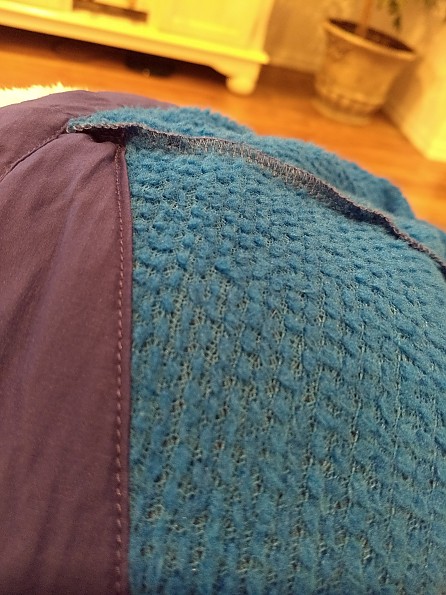
Exposed "cookie monster" lining. Usually this is hidden by a lining but OR decided it was durable enough without it. They saved weight and added breathability. I have to agree; good idea. Will it be abrasion resistant forever? I think so, but time will tell.
Fit: I'm 5' 10" and a tad over 190lbs. This jacket fit close but stretched, making movement easy.
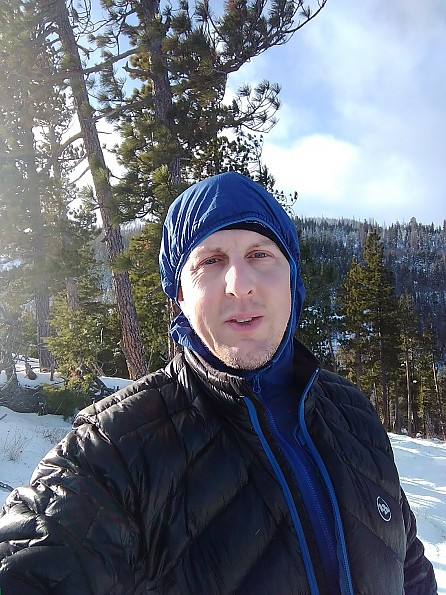
The hood is designed to fit under helmets and is slightly snug. This pic was taken in temps in the lower twenties with strong winds.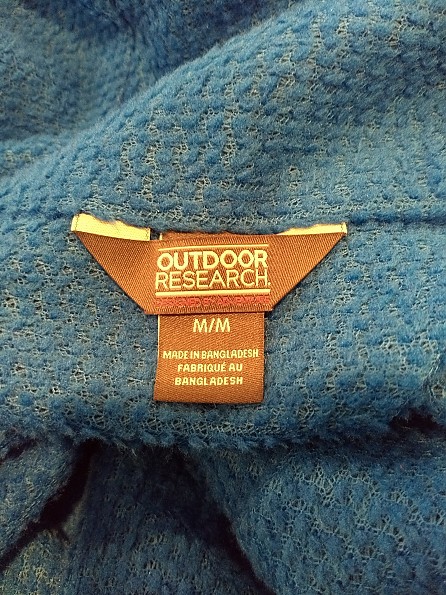
Warmth: This jacket is warmer and more windproof than a fleece and not quite as warm as your average down jacket, but where it really works well is when you are hiking or otherwise on the move. It is a perfect addition to a conventional layering system; over your base layer and under your shell.
Why not a down jacket? Bulk. This jacket is thin enough to fit under a shell and provides breathable warmth without the bulk of feathers. Besides, down quits working well when you compress it under other layers.
Features: The hood is adjustable with a shock cord as is the hem. The cuffs are elastic and do not adjust and there is no zipper on the handwarmer pockets. Inside one of the handwarmer pockets there is a clip to secure a keyring. Not sure what the loops on the cuffs are for; they are too small to serve as thumb loops. There is a chest pocket that zips securely for those things you need often.
These tiny loops on the cuffs puzzled me a bit. They were too tight to be used as thumb or finger loops. Perhaps they attach to a shell jacket or gloves but I can't tell.
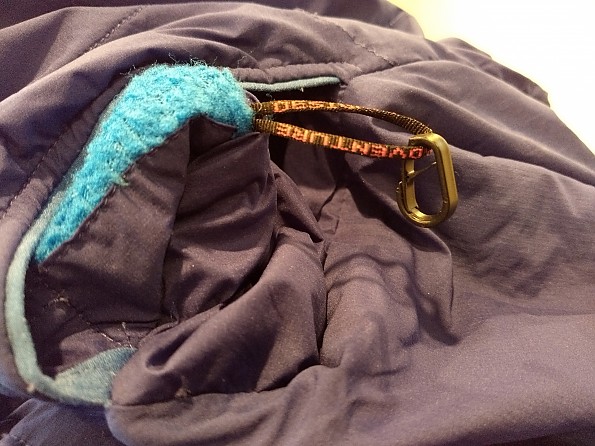
Since the pockets don't zip closed there is a clip to secure keys so they don't fall out. I'd prefer a zipper though.
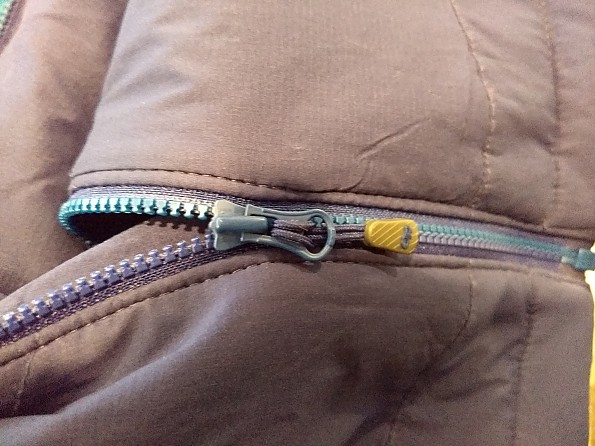
Decent zippers; not flimsy but not overly bulky
Testing Conditions: When I wasn’t wearing this jacket in town everywhere (it looks great) I took it skiing and on an overnight backpacking trip in 50 mph gusty wind, freezing rain and snow. My anemic, three-season sleeping bag wasn’t cutting it at night so I slept in the Ascendant jacket with the hood on. In the middle of the night I had to go outside and build a snow wall to keep the wind at bay and I stayed warm in it as my only layer besides a rain shell. I wear it daily during my lunch break runs where temps hover in the 25-33 degree (F) range.
Packability: It packs into its own pocket, competing nicely with down jackets.
Weight: OR claims 13oz, which is actually LIGHTER than many down jackets in its class.
Durability: This class of jacket is not for bushwhacking but it holds up as well as any other in this class. Think of it as a tad tougher than a down puffy coat. My pack didn’t wear any rough spots on it and the zipper always works flawlessly. I have no complaints. Every three to five years, if you are an avid hiker/climber, you’ll need to replace your mid-layer. I see this as no different. If you are careful with your gear (I’m not), who knows, it may last longer.
I'm a bit concerned that the exposed lining will wear out faster than if it were not, but I can see no issues so far.
Final Thoughts: As companies like OR keep innovating and elevating their game we can take advantage of their advances and have some pretty great gear. When you need a midweight jacket you can't do too bad with the OR Ascendant.
Source: received for testing via the Trailspace Review Corps
(Sample provided by Outdoor Research for testing and review)
Shockingly warm for the weight and highly breathable with just the right amount of wind protection. This jacket is a great insulation layer for winter activities such as backcountry skiing and ice climbing. It's become my go-to insulation layer for winter.
Pros
- Warm
- Lightweight
- Breathable
- Moderate wind protection
Cons
- Not super small when packed
- Would prefer zippers on hand pockets
- Sad colors, I wish there were brighter colors to choose from
I am very impressed by this jacket and it has become a staple part of my winter adventure suit replacing the Patagonia Nano Air Hoody. I'm 5'4" 125 lbs with a very athletic build and the small fits great over long sleeve baselayers and lightweight fleece such as an R1.
The Ascendant is long enough that it stays down under a pack. According to my kitchen scale the Ascendant weighs 60g less than the Nano Air in size small. It is warmer than the Nano Air and has about the same breathability and wind resistance. The folks at Polartec worked some magic with the Alpha Direct insulation used in this jacket. The Alpha Direct does not need a lining like most insulations, the soft fluffy fleece is exposed on the inside of the jacket. It is light warm and soft on the skin and slides well over most baselayers.
The zippered chest pocket easily fits a normal size smart phone, and while the two hand pockets are handy I do wish they were zippered. The hood has a drawcord to reduce the volume, but I haven't used it yet. The hood does layer well over a beanie or hat, but is not big enough to fit over a ski helmet.
I have put one small hole in the sleeve, but that was from a battle with a tree and the tree won. The jacket doesn't pack down as small as a down jacket but is much more breathable especially when doing aerobic activities such as skinning uphill. One of my biggest complaints is that the colors to choose from were kind of sad and I ended up getting a dark teal jacket with a gray lining. Since I use this jacket so much in the winter in the back country I would have preferred something much brighter.
Overall I highly recommend this jacket if you are looking for something light and warm to use in fall, winter, and spring.
Background
I've owned this jacket for four months and use it several times a week. I got it for backcountry skiing, but I also wear it around the house, at work, climbing, camping... It has kept me warm skinning uphill in single digits with a midweight baselayer underneath and in the cold office I work in.
Source: bought via a "pro deal"
Price Paid: $100
Your Review
Where to Buy
You May Like
Specs
| Men's | |
|---|---|
| Price |
Historic Range: $79.98-$249.00 |
| Women's | |
|---|---|
| Price |
Historic Range: $69.99-$249.00 Reviewers Paid: $100.00 |


